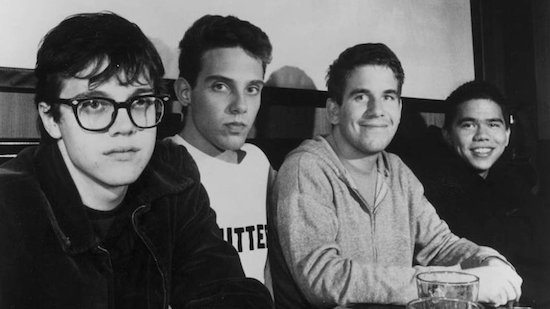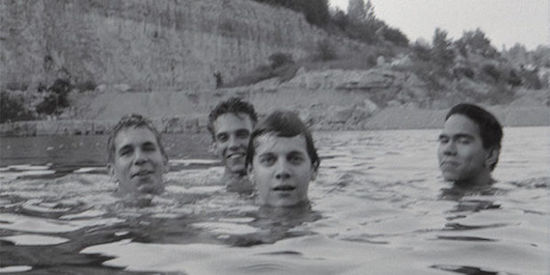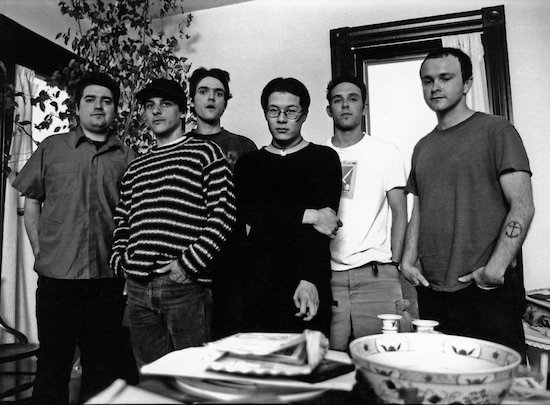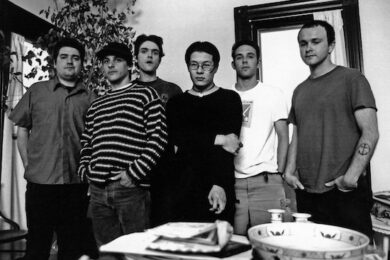Before you read on, we have a favour to ask of you. If you enjoy this feature and are currently OK for money, can you consider sparing us the price of a pint or a couple of cups of fancy coffee. A rise in donations is the only way tQ will survive the current pandemic. Thanks for reading, and best wishes to you and yours.
It’s rare to be able to pinpoint the albums that really made an impact on the course of rock music’s trajectory – that weren’t just influential, but actually changed things. Yet Spiderland by Slint is unarguably one of those albums. Released in 1991 after the band had already split up, the prospect of it selling more than a few thousand copies, let alone going on to become a genre-defining phenomenon, seemed remote. Yet its reputation has continued to grow to the extent that, by the time of its inevitable bells & whistles reissue as a boxset in 2014, it was regularly being lauded as one of the most important records ever – The Guardian’s description of Spiderland as “the album that reinvented rock” was typical of articles from the time.
Spiderland has already been written about at length, so apologies if some of what follows treads familiar ground, but it’s not the main reason I’m writing this piece. Instead, I’m more interested in what came after Spiderland – specifically, The For Carnation, the self-titled album released nine years later by the band formed by Slint’s ex-singer and guitarist Brian McMahan. In particular, this is what intrigues me: while Spiderland remains a dazzling star in rock’s firmament, why is The For Carnation practically invisible in the alternative canon?
Of course, on the face on it, this is a ridiculous question. Everybody has their own personal clutch of uncelebrated albums that If Only People Would Listen, would be revealed as the masterpieces they almost certainly aren’t except in our own heads – it’s what music fandom’s all about. But history’s oversight of The For Carnation is to me more perplexing than that. Released as the cult of Slint was still gathering steam, it’s an album that shares Spiderland’s sepulchral atmosphere and enigmatic lyricism, and has an obvious connection that sets it apart from the various bands that followed in Slint’s wake. More to the point, it’s also really good – in fact, revelatory in places.
There are all kinds of reasons why certain albums/bands succeed while the grand majority fail, though often as not, it’s down to a random and unforeseen alignment of people and circumstances. Yet given its pedigree and the sheer quality of the music, I feel that The For Carnation deserves more than being just a minor footnote in the mythology of Slint. But as we’ll see, its obscurity may have something to do with the nature of the genre that Spiderland unwittingly helped to create.
It’s fair to say that 1991 was quite a year for rock, even if its full effects would only be felt retrospectively. At the time, both baggy and shoegaze, the two dominant forms of indie music in the UK, were starting to feel tired, with the real innovations in sound increasingly coming from the techno and breakbeat hardcore scenes. But what nobody saw coming was the grunge tsunami generated in September by the release of Nirvana’s Nevermind, a record which would rapidly reconfigure rock and alternative music on both sides of the Atlantic, and become another of those epochal albums.
Yet under the path of this tidal wave, another world was coming into being. Released a week before Nevermind, Talk Talk’s final album Laughing Stock crept out into the racks, mainly to benign puzzlement. In November, Loveless, My Bloody Valentine’s long-awaited follow-up to Isn’t Anything, finally emerged – though rather than reinvigorating the shoegaze scene, its sonic experimentation rendered most bands obsolete. But coming before all of them in March was Spiderland, this mysterious slab of gothic American art rock. While impossible to divine at the time, these three albums would become the foundation stones of what was eventually termed post-rock.
When Slint made Spiderland, they obviously weren’t intending to start a new chapter in alternative music – they were just trying to record as best they could the songs they’d been playing for months in their basement rehearsal room. Whether or not they knew quite how extraordinary these songs sounded is another matter. Based on the evidence of Breadcrumb Trail, the fantastic documentary by Lance Bangs included with the 2014 boxset, the answer remains unclear, though they certainly knew they were onto something – for all the surreal goofing around common to most young bands, the performance of the music itself is both serious and intense.
On its release, Spiderland really did feel like something else. I already had their first album Tweez, so knew the general area they were operating in, but from the crystalline opening guitar line and first murmured words of ‘Breadcrumb Trail’, it was clear that the music had progressed to another level. Whereas Tweez had swung between jazzy exuberance and claustrophobic downpours of noise, Spiderland was perfectly weighted and controlled, albeit with a creeping undertow of tension throughout.
It’s an easy album to throw adjectives at – dark, brooding, uncanny – but my overriding impression at the time was of songs that were more like spells, so carefully structured yet utterly present that they acted as a conduit to somewhere else. If all art is a form of magical creation – bringing something into being that didn’t exist before – then Spiderland is at the apex of this process. While the elements that went into its making appear simple enough, the way they combine on the record is pure alchemy.
It’s the kind of album that seeps into your soul and colours your experience of the world. For all its precision, this is intimate and deeply personal music, yet possessing the vivid power of a vision. There’s a world-weariness at the heart of the words, the obscure tales of fortune tellers, vampires and Ancient Mariner-esque sole survivors suggesting a confrontation with fate, while the more biographical lyrics show characters in the midst of some kind of crisis. But what’s particularly vital is how the instrumentation acts as a channel for thoughts and emotions too – listen to how ‘Washer’ twists its hands and glances nervously this way and that, before suddenly exploding in release. One of Spiderland’s big differences from the post-hardcore scene that had spawned Slint, and from rock music in general, is that big riffs and noise are never deployed just for effect or as an analogue of raw power – instead, they’re always an integral part of the story being told.
In an interview with MOJO, bassist Todd Brashear, who joined the band post-Tweez, said, “I think it’s kind of disturbing that people that young were making music like that.” It’s an understandable reaction given the fact that Slint were barely out of their teens when they made Spiderland. And there is something a little frightening about just how accomplished the album is. How had they managed to imbue it with this supernatural level of maturity? How exactly had they reached this special place? This aura of mystery would become a key element of the buzz that gradually build around the album over the following years.

The fact that Spiderland got a release at all is unusual given that the band had imploded soon after its recording, and there was no chance of it being promoted live. It’s testament to the belief that Corey Rusk at Touch And Go had in the excellence of the music that his label put it out. Expectations of it making any kind of impression couldn’t have been high, but it’s not true to say that its release went entirely unnoticed.
Crucially, Melody Maker published a review of Spiderland by Steve Albini in which he used it as a stick to beat the complacency of the American music scene, and predicted that “in 10 years it will be a landmark”. Albini had a long-standing association with Slint, having recorded/produced Tweez, while Big Black had been an influence on the band’s early sound. But more to the point, the uncompromising Albini was held in high regard by many MM readers (at a time when music papers still held significant sway), and so an album that he described as “flawless” and “genius”, and had nearly moved him to tears, was sure to pique the interest of his followers.
It’s tempting to say that, just as The Velvet Underground & Nico didn’t sell in huge numbers, but supposedly everyone who heard it formed a band, Spiderland was disproportionately influential among musicians of a certain ilk – even if it took a little while for this to become noticeable. Despite what Albini said, the sound of Spiderland hadn’t been completely unprecedented in the post-hardcore scene – Bitch Magnet had partly prefigured it on 1989’s Umber, while the slowcore of Codeine also inhabited similar territory. As such, the American bands that initially came after Spiderland such as Rodan and Chavez latched onto the precision and soft/loud dynamic of its sound to birth the math rock genre – as its name suggested, music that came out like algebraic formulae and was often suspicious of melody.
There were similar tendencies in Britain, though also a Slint-esque vulnerability in the mathy sounds of bands such as Nub and Zoopsia on the London gig circuit. The first flowering of what Simon Reynolds would soon refer to as ‘post-rock’ also began to take place around the same time, though for bands like Bark Psychosis, Disco Inferno and Seefeel, the manipulated noise of Loveless and the spacious soundscapes of Laughing Stock were clearly more influential than Spiderland’s relatively traditional palette of guitar/ bass/ drums.
However, by the mid-90s, something was stirring in the underground. Spiderland began to be referenced in interview and on record, both by up and coming bands such as Telstar Ponies and more established acts like Radiohead. But Slint’s sound became indelibly associated with the post-rock tag with the arrival of Glasgow’s Mogwai, who adopted and ran with a similar template of ruminative passages of bass and guitar counterpointed by sudden lurches into thrilling heaviosity.
The success of Mogwai over the following years can’t be underestimated in advancing Spiderland’s agenda and directing more and more people to the album. Mogwai showed that it was possible to reach a large audience with a sound that valued subtlety and dynamics over choruses and solos, and that the music itself could be the primary vehicle for a song’s emotional content – because unlike Slint, Mogwai went the whole hog and dispensed with vocals altogether. A host of instrumental groups soon followed Mogwai’s example – most notably London’s Billy Mahonie – all of whom cleaved to one of Spiderland’s essential tenets: that the quiet parts of the music could be just as beguiling as the noisy bits, if not more so.

While it’s the music that ultimately made an impact, Slint’s disappearing act after producing their masterpiece helped to both fuel the notion of Spiderland as an exceptional album and to enhance its mystique. In the pre-internet days, it wasn’t easy to find out about records other than via the music press/fanzines, possible plays on Peel, or hand-written notes on sleeves in specialist record shops (particularly important in the case of Spiderland, because the front cover had neither the band’s name nor the title on it). As such, word of mouth was a vital method of communication – but where no firm facts existed, conflation and conjecture filled the vacuum. Rumours circulated that the band had undergone a collective nervous breakdown or even that members had died.
The truth is less sensational, though not without a mythic dimension. A few weeks before the recording of Spiderland, completed in one marathon weekend session, Brian McMahan had been hospitalised after being struck by a car. While shrugging off this brush with mortality at the time, McMahan has since conceded that his survival was “pretty miraculous”. He would return to hospital immediately after the recording session, assumed at the time to be due to the after-effects of the accident, but more likely for depression. In a state of anxiety, troubled by the pressures of his parents’ expectations and the stress of running Slint, McMahan told the other members that he was leaving the band, effectively bringing it to an end.
For the next few years, Slint’s ex-members did indeed keep a low profile, but by the mid-90s they had started to emerge again. Guitarist David Pajo joined Chicago-based post-rockers Tortoise and began recording as a solo artist, while McMahan formed The For Carnation and released the EP Fight Songs and the (mini) album Marshmallows. Although clearly sharing an aesthetic with Slint, the instrumentation on these recordings is stripped back and the slowcore influence more pronounced. The exception is ‘I Wear The Gold’ from Marshmallows, which crackles with the same electric dread as Spiderland’s darkest moments.
While perfectly respectable releases, they didn’t suggest that McMahan had another special album inside him. Yet in retrospect, these initial records were more a wiping of the slate, a necessary exorcising of ghosts ahead of TFC’s self-titled ‘debut’ album. Because like Spiderland, this is a record on another level. Recorded in a variety of studios over a 12-month period, with the five-piece band complemented by a long list of additional musicians, its making couldn’t have been more diffuse than Spiderland’s manically focused creation. And yet it shares the same sense of a hermetically-sealed bubble being pulled over the listener’s head, a complete sonic experience rather than just a collection of songs.
It creeps up on you, the soft, querulous organ that opens ‘Emp. Man’s Blues’ like a torch in the dark. It’s joined by a shivering cello, a slow, lugubrious bassline, and brushed snares, all playing as though not to disturb the nocturnal atmosphere. Whereas previous TFC recordings tended towards lo-fi naturalism, there’s an enveloping density to the sound here, despite the relative simplicity of the instrumentation. McMahan begins to speak-sing, quiet as ever but with a new-found authority in his voice, delivering lines such as “There was no anything outside” with suitable menace. He sounds like a man trapped in eternal twilight, yet resigned to his situation, even empowered by it (as the title suggests): “Now when I fall to earth, I hear applause”.
The sound gradually builds – first strange twitters of space echo, then some delicate guitar vamping a la Neil Young’s ‘Down By The River’ (Young is one of the few identifiable ‘classic rock’ influences on Slint – listen to this tremendous live version of ‘Cortez The Killer’ from the Spiderland boxset). Best of all, the gravid orchestral flourishes heard earlier in the song start to twist and pout, resembling nothing so much by its conclusion as the strings on David Essex’s avant pop classic ‘Rock On’. Unlike the fragments and vignettes released before by TFC, this feels like proper world-building again.
The album takes a deliciously sinister turn now. If Spiderland felt like a series of Edgar Allan Poe stories brought to life, The For Carnation is more indie horror movie, episodes of disquiet conjured from found footage and spectral static. The deep bass and phased drums of ‘A Tribute To’ is trip hop in a thick fog, its spidery guitar painting nervous pictures as McMahan intones, “Child, go back inside, where is your father now?” Shards of noise and random transmissions loom in and out of the mix, adding to the post-apocalyptic vibe: “I’m one of those not dead." Whereas Spiderland had a trebly, chiming intensity to it, The For Carnation exists in a pitch black lower register, with only occasional glimmers of light breaking through.
The instrumental ‘Being Held’ is even more nerve-jangling, suggesting a hostage situation rather than a loving embrace. A distress call rings out that no one heeds, slumbering citizens oblivious to the captive’s predicament, or perhaps their own doom. Britt Walford’s drums burst into an insistent break, but a viscous feeling of unease remains (Walford, McMahan’s childhood friend and co-driving force behind Slint, guests on just this track). ‘Snoother’ is jazzier and there’s a warmth to its keys, but something’s still not quite right – McMahan’s measured vocals are double-tracked by That Dog’s Rachel Haden, but less in harmony, more like being stalked by an unseen twin. And then ‘Tales (Live From The Crypt)’, after a brief appearance from Kim Deal, plunges back into the 16mm gloom, McMahan narrating from the heart of a fever dream. With its distorted organ and juddering guitar, it’s like diseased prog, a Floydian nightmare crushed down to its essence.
David Pajo believes that Spiderland works so well as an album because it builds to a big finish, and in its own way, The For Carnation does the same thing. ‘Moonbeams’ seems to rise out of the preceding darkness, like clouds clearing across the lunar surface. The sound remains sombre and reflective, but there are little seeds of joy inside it as well, analogue pulses and wave forms at the periphery. The strings are also back to soothe our brow, as McMahan tenderly relates an obscure lament, which culminates in the repeated line, “Who did this to us?” There’s a sudden swell of sound and the guitar momentarily crests, before falling away again, back into the velvet inkiness.
If Spiderland, as its opening song suggests, is a rollercoaster, all peaks and troughs of terror and exhilaration, then The For Carnation is a ghost train where the apparitions only appear at the edge of our vision, and are all the more unnerving for that.

The For Carnation live by Tom Cops
Released in April 2000, The For Carnation got decent reviews and the band even came over to the UK to play the first, Mogwai-curated ATP. I attended the warm-up gig they played at The Garage in London, and remember McMahan being pushed so far stage-right behind his keyboards as to be practically invisible to the crowd. It perhaps wasn’t the best venue to play out a brand new album of slow-paced, cryptic mood music… But if TFC required intimacy and hushed attention to be best appreciated, they were travelling in the wrong direction in terms of the burgeoning post-rock scene. Most of the earlier, more experimental groups had long since fallen by the wayside, with the genre (and it was very much a ‘genre’ by now) increasingly predicated around the dramatic, dynamic shifts in sound that Slint had pioneered and Mogwai had helped to popularise.
In the same week that TFC were playing a small gig in Islington,
a pre-exclamation mark shift Godspeed You Black Emperor! and Sigur Rós had a show at the Royal Festival Hall. Both bands were relatively new on the post rock scene, and arguably existed at opposite ends of the tonal spectrum – Godspeed brooding and apocalyptic, Sigur Rós glacial and transcendent – but what they both shared was a sense of scale. The listing for this gig even describes Godspeed as “the awe-inspiring Canadian ensemble”, and this was how post rock was now received by its audience, as a pseudo-classical soundtrack evoking wide-screen images of both catastrophe and salvation.
It’s easy to depict The For Carnation as an album out of time, the transmissions from its low-light ghost world drowned out by the grand gestures of post rock’s next generation. Yet listening back to it, you can hear parallels with other contemporary music – there’s a similar sense of Massive Attack’s pre-millennial tension, and its subtle use of electronics and sampling would be magnified later in the year by Radiohead’s Kid A. However, the fact remains that The For Carnation and the band itself quickly slipped out of view, McMahan either unwilling or unable to push his muse any further – and this time, there would be no Spiderland-style second act.
In truth, it’s unrealistic to expect lightening to strike twice, but for me, The For Carnation has that same air of magical creation about it, an entire world summoned into being. In short, a special record. In at least asking the question and pondering its invisibility, I can only hope that a few more people are drawn in and fall under its spell.



